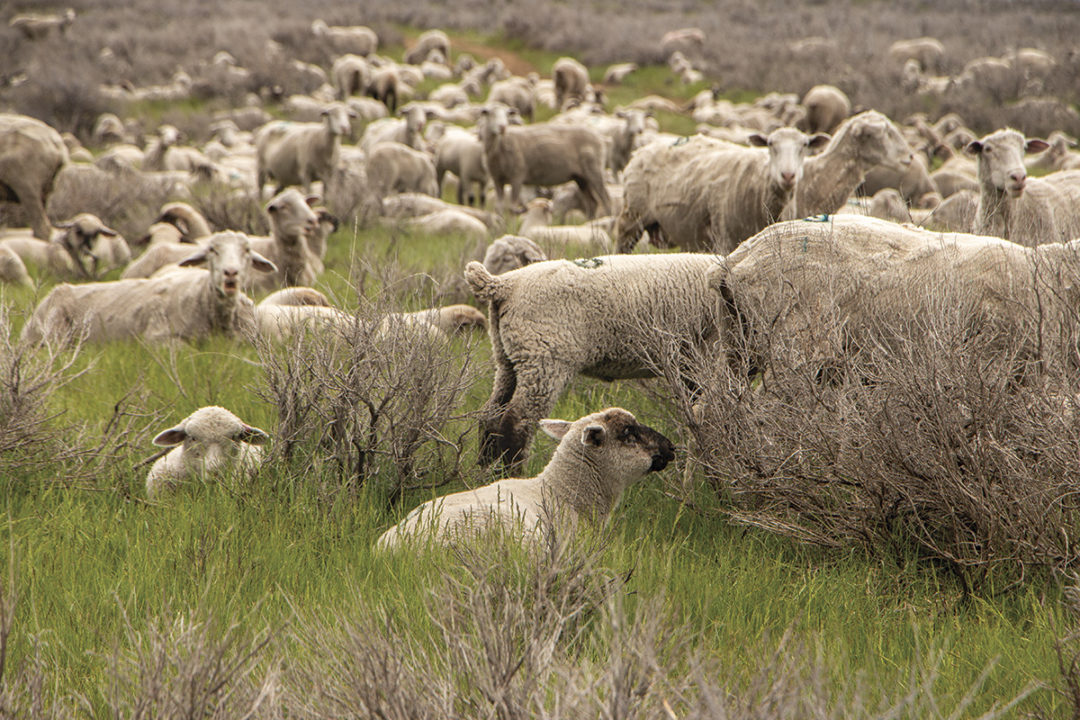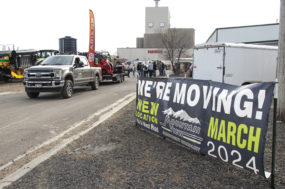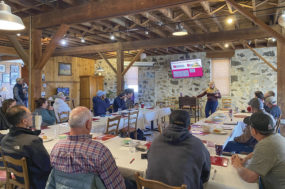I’d like to tell a story: a tale of a rough-and-tumble mountain man who trailed 9,000 sheep across some of the most forbidding Western regions on the continent, delivered nearly all of them to their destination and went home with a tidy profit.
It was January 1848 in California. At a small sawmill in the hills northeast of the fledgling agricultural settlement of Sutter’s Fort, one of the owners discovers something interesting in the millrace: tiny flakes of a shiny metal. Gold. Gold! Soon the word got out and spread everywhere. The great California Gold Rush was on. By the end of the year, men from Oregon and other places start showing up to pan for gold. In 1849, thousands more arrived. The press started calling them “forty-niners.” Men streamed in from everywhere. Ships anchored in San Francisco Bay and then lost their entire crews to the gold fields. By 1850, Sutter’s Fort had become Sacramento with a population of nearly 7,000, which would double in 10 years. On the coast, the village of San Francisco mushroomed to 36,000 people by 1852. By 1855, more than 300,000 hopeful souls had flocked to California.
But not everyone made money, and not everyone panned for gold. Most of the men who worked the gold fields came home with nothing. But some folks came to California for other reasons: They figured they could make money by servicing those men who looked for gold. Win or lose in the gold fields, everyone needed shovels and pickaxes, clothes and food. That’s where the real gold money lay – and that’s where our sheep story begins.
People wanted to eat meat, and the meat of the day was sheep (mutton, really, but still quite a delicacy compared to no meat). The nearest place with large numbers of sheep was a thousand miles away in northern New Mexico. The lush Rio Grande Valley was home to large bands of churro sheep, animals descended from the original stock brought to Mexico by the Spanish conquistadores and first settlers. In the early years of the Gold Rush, lured by a hungry population, some stockmen had already trailed a few flocks to California from New Mexico. There were potentially great rewards but there were also great risks. This was a harsh land – deserts, mountains, wide-open spaces with no towns or highways. Just a hard dry country with some native tribes who were not enthusiastic about white interlopers with their bands of ravenous animals.
Into this scene came a colorful character, Uncle Dick Wootton. Originally born in central Virginia as Richens Lacy Wootton, he spent his youth in Kentucky and Mississippi and then headed West. As a young man, he roamed all over the unexplored West. He became known as a superb hunter, trapper and military guide, and also a frontier fighter. Somewhere along the trail, people started calling him “Uncle Dick.” In the 1840s, he even tried his hand at ranching – he raised beef cattle and bison calves together and trailed them to Kansas City for a good profit. One of the true mountain men, he was shrewd and resourceful. His life was filled with the same types of adventures as his better-known historical peers like Kit Carson, Jim Bridger and John Colter.
In 1852, Wootton was 36 years old and living in Taos, New Mexico. The California Gold Rush was in full swing, and he had an idea. No, he wasn’t going to squat by a stream and pan for gold. Instead, he would make money by feeding those men. He already knew how to move animals, so he would trail some sheep to the gold fields of California. After all, it was only a thousand miles or so.
In the spring of 1852, Uncle Dick purchased sheep from ranchers across northern New Mexico and assembled a large flock. On June 24, he left Taos and headed west with 9,000 churro sheep, along with 22 hired men, eight goats, a string of pack mules and one trained sheep dog to handle the stragglers.
There were no contemporary travel records in 1852. The GPS system hadn’t quite been invented yet, nor Google Maps. Fax machines were kind of rare, and Uncle Dick was a notoriously slow blogger. Nonetheless, I’ll try to sketch his route.
From Taos, the flock trailed north and west up the Rio Grande River toward its headwaters deep in the Colorado Rocky Mountains. Cutting north, they crossed the Continental Divide and reached the Uncompaghre River near modern-day Ouray (there was no town there, just the river).
In the San Juan Mountains near Cochetopa Pass, en route to the river, they had a bit of a run-in with a raiding party of the local Ute Indian tribe. Uncle Dick had a heated discussion with the Ute chief, Uncotash. Legend has it they settled their dispute in the time-honored tradition of a full-scale brawl, and Uncotash found himself on the ground with Uncle Dick’s knife at his throat. Uncotash prudently renegotiated the issue and settled for some flour and ammunition, and the flock was allowed to continue on.
Wootton followed the Uncompaghre downstream until it ran into the Gunnison and then to its confluence with the west-flowing Colorado River. But when the Colorado turned south, Uncle Dick left that river and struck west across open country. He brought his flock across central Utah and the Wasatch Mountains to Spanish Fork, just south of the young settlement of Salt Lake City. Since they were near the town, Uncle Dick went into Salt Lake for supplies and ended up having supper with Brigham Young. After this side-trip, Wootton trailed his flock westward across the Utah desert, passing through what is now the Dugway Proving Grounds, and crossed into Nevada near the modern-day hamlet of Ibapah. Then they angled northwest to the Humboldt River, followed it downstream, left the river to cross another desert to the Carson River, south of Reno. Then they traversed the Sierra Nevada Mountains (just before a heavy snowstorm reached the American River) and followed it downstream into the Central Valley of California. On Oct. 9, Wootton and his crew and 8,900 sheep arrived at the small town of Elk Grove, 15 miles south of Sacramento. (Using modern roads and the interstate highway system, Google Maps calculates the distance at 1,277 miles.)
It’s 107 days from June 24 to Oct. 9. Let’s think about this for a moment. Dick Wootton started in Taos, New Mexico with a flock of 9,000 sheep and arrived 107 days later in Sacramento, California, with 8,900 animals. A sheep drive of more than 1,200 miles over uncharted mountains, across deserts and fording rivers. That’s walking sheep at least 12 miles per day for 107 days with a stock loss of only 1%. No roads, no towns, no safety net, no published maps. The only map was in his mountain man’s head.
But there is more to this story. Uncle Dick wintered his flock near Elk Grove while he made arrangements to sell his animals. By late spring, he sold the sheep for more than $50,000. He had originally purchased the flock for $5,000. You might say he made a profit.
After his sheep drive, Dick Wootton returned to Taos, farmed some land near Pueblo, Colorado, and then ran a hotel and restaurant in the frontier mining town of Denver, where he was an original signor of that city’s incorporation papers. In the late 1860s, Wootton built and blasted a 27-mile toll road through the rugged Raton Pass between Colorado and New Mexico, where I-25 now carries high-speed traffic. He charged most travelers to cross his road except for Indians, whom he gave free passage. In 1879, he sold the rights to his road to the railroad for $1 and a lifelong monthly stipend and food money (today we would call that a smart annuity). Uncle Dick Wootton, one of the bona fide mountain men in this country, died quietly in his Raton Pass home in 1893 at the age of 77.
Let’s end with a few calculations: Uncle Dick purchased his sheep for an equivalent of 56 cents per head (= $5,000 divided by 8,900 to account for livestock losses). In 1850, the average daily wage was only 90 cents, which means that wages for 22 men for 107 days was $2,119. Add in supplies, winter yardage and such, and let’s round Wootton’s expenses to $4,000. Which means that his net profit was $41,000, or $4.61 per head. Back then, folks worked six days a week – roughly 280 days per year – so the average annual salary of a workingman would have been $252. Dick Wootton’s profit of $41,000 was 163 times the annual salary of the average working person. In today’s terms, if we consider that an average annual wage is $20,000, then applying the same ratio in today’s money, Uncle Dick’s legendary sheep drive would have netted him a tidy profit of $3,260,000.
Yes, Virginia, there was indeed gold in California – not only in the ground, but also in sheep.


.jpg?t=1687979285&width=640)





